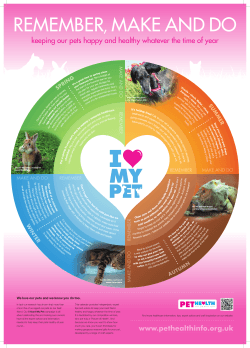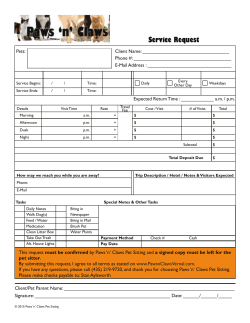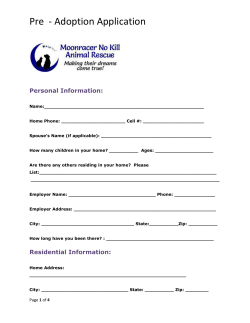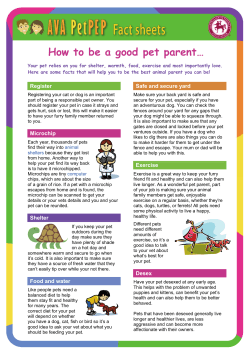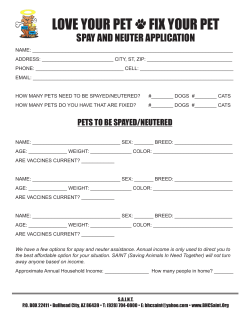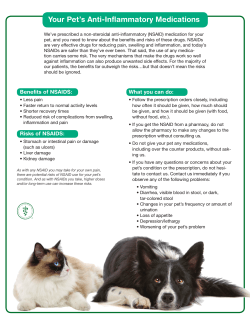
World petfood market trends
World petfood market trends Pet parenting Enjoyment Health & Well-being Responsibility By Chloé Champion DIANA PET FOOD Division SPF Europe Marketing Director Global Markets & trends Manager Innovation INTRODUCTION Pet food market launches analysis (SOURCE MINTEL GNPD) Enjoyment, health & well-being, responsibility and conve- A.Claims trends in pet food between 2003 and 2013 Mintel GNPD provides a database of all pet food products launch across 53 countries. These products have multiple claims. Using a Correspondence analysis (a multivariate statistical analysis) we studied trends in claims for pet food. The years between 2003 and 2013 are divided in 3 distinctive periods: > Between 2003 and 2006 “Vitamins & Minerals Fortified” was a very popular claim. Communication on weight management focused on “Low/No/Reduced Fat” and “High/Added fiber” claims. Launches of “vegan/Vegetarian” products were also more frequent. > Between 2007 and 2010 products mentioned “Added Calcium” and “Low/No/Reduced Sodium”. Communication on weight management focused on “High protein” and “Low/No/Reduced Carb” claims. > Between 2011 and 2013 products displayed claims linked to responsibility (“Environment Friendly” or “Charity”). Communication on weight management focused on “Low/No/Reduced Sugar” and “High Satiety” claims. “Social media” claims started to appear in 2013. Regions also have different claims trends. The North American market launches more “All Natural” products. “Gluten Free”, “Hormone Free” and “Vegan/vegetarian/No animal Ingredients” claims are also specific of North America. Europe is more concerned about “GMO Free” products. Asia and Latin America display a higher number of claims related to the pets’ health benefits such as: “Digestion & Urinary Tract”, “Skin & Coat”, “Immune System” etc. SPF (Diana Group) SPFPROPERTY- Diana SPF (DIANA North © All America Group) Copyrights PROPERTY— Treats, reserved Kibbles © -All Innovation Copyrights & TrendsDays —reserved © 2013 02 2 STRICTLY CONFIDENTIAL- NO USE or COPY ALLOWED STRICTLY CONFIDENTIAL- NO USE or COPY ALLOWED nience are the 4 mega trends that dominate the development of the pet food market worldwide. Accordingly, manufacturers design new products that in turn shape new concepts and change the perspective we have on these trends. New product launches and ideas from across the globe will illustrate specific undercurrents that constitute the 3 first trends (Enjoyment, health & well-being and responsibility). . B.Packaging trends in wet pet food in 2013 Can remains the most popular format for product launches. Nevertheless specificities exist: tray is a popular format for dog in general and in Europe especially, pouch is a popular format for cat especially in Europe. Meat as the 1st ingredient. Some manufacturers (such as Hill’s) work on the formulation of their products to put the quality protein as the first ingredient, because some consumers are making product choices based primarily on a set criteria for ingredients, rather than the overall promise of nutrition or clinical research. Wet dog most popular format is can of 301-400g. In 2013 Asia and North America were the 2 regions with launches of SKUs 100g and below (pouch below 80g in Asian, trays of 80-100g specificity in NA and Asia). An increasing number of products are launched with communication on the content of animal protein (as opposed to protein from vegetal origin). Wet cat most popular format single serve of 80-85g in can and pouch, trays are mainly launched in 86-100g. A new trend of very small packaging 50g and under is slowly emerging in Europe and Asia. “Fresh Meat” and “Real Meat” are claimed on packaging to promote the premium quality of the product. However, for dry pet food it is technically complicated because of the limited level of fresh meat that can be introduced in an extruder (below 45%). Enjoyment A. Premiumisation and Meat oriented claims Premiumisation is a consequence of our consuming society. The growth of non-traditional households with no children and high levels of disposable income are boosting per-capita pet expenditure. Increased wealth give consumers more disposable income to spend on their pets. And finally the growth of celebrity culture has made the pampering of pets more socially acceptable. The consequence is that pet owners are willing to pay for more value added products. To match the true nature of pets (carnivorous), an increasing number of products are launched with “meat claims”. B. On of Iams ad campaign. 3 Chloé Champion - World Petfood Market Trends Humanization: fruits & vegetables The human population evolution presents a falling birth rate, an ageing society and an erosion of traditional family. All these facts impact widely the demand for emotional bonds. This has also affected the pet owner bond. Therefore, the pet is not only an animal but a member of the family and can even be considered as a child. It had a deep impact on the pet food industry, driving communication and products development towards a very emotional appeal. Health & Well-being Increasingly concerned about the health and well being of their pets, today’s pet parents want to feed their natural and healthy products ensuring longevity and wellness. Expenditure of health and wellness is rising rapidly as consumers look to improve their pets quality of life. A.Naturality: Limit additives and preservatives, limit number of ingredients, “grain-free” products Pet owners increasingly expect the same high standards from their pet’s food as their own (63%), with bigger human food trends like interest in “natural food” thus reflected on the pet food market. Their first concern is to buy product with less or no additive & preservative for a more healthy diet. Naturality of products means also natural formulation with a limited number of ingredients the pets consume: simpler formulas just like human food. What started out as a niche market owned by local players a few years ago is slowly becoming a mainstream market as more and more major players launch their own “Grain-Free” products. It is an answer to consumers interest for “free from” formulations mostly influenced by the food they eat, but also because of animal intolerance to gluten (although it is not widespread), and better digestion of animal protein and fat (again catering to the true nature of pets). Responsibility A. Quality: Origin of ingredients, local sourcing, sustainable sourcing > Origin of ingredients: provenance has been a clear differentiator in recent years. It has helped marketers convey the notions of authenticity, quality, and traceability and make their products sound “real”. > Local sourcing: to communicate on Security, Quality, and Freshness of products. A claim “Made in....” will enable manufacturers to insist on regional sourcing. In the US some manufacturers advertise “Not made in...” (focusing on products free of Chinese ingredients which have bad press since the 2007 melamine crisis). > Sustainable sourcing: quality of products also means respect of the environment and eco systems. Some labels certify the sustainable sourcing of raw materials, the MSC label is seen on fish pet food products but also on human food. SPF (DIANA Group) PROPERTYSPF - Diana © -All Innovation Copyrights Days reserved 2013 4 STRICTLY CONFIDENTIAL- NO USE or COPY ALLOWED Manufacturers are looking for novel ingredients for better brand differentiation. Consequently a growing number of products contain fruits (mostly red fruits for anti-oxidant content) and herbs (ginkgo, ginseng, valerian, chamomile, spices etc.), as recipe component or as real peaces in the preparation. But, where can we find new ideas? Look cross-category Look abroad for ideas that can be translated to the local market “Steal with pride” & “Copy and improve” Adapting the packaging concepts to other products can be a good alternative. Remember that there are few new concepts, just new applications. So, you can take what works, and make it better, just customizing an existing concept to your brand. Ideas I liked Innovation is often perceived in the developed countries as technological revolutionary products tried and tested by early consumers. Trendy and expensive products are adopted firstly by the top of the pyramid and usually trickle down to the masses. On the other hand, in the emerging markets innovation is about reconfiguration and re-bundling products and processes to fulfill needs at a lower cost. Many new innovations that are considered “frugal” will emanate from the emerging world and into the developed economies. Currently, it is estimated that 80% to 90% of all introductions globally are merely changes of flavor or fragrance or package size. Very few products or packs are truly innovative 5 Chloé Champion - World Petfood Market Trends The most important thing is: BRINGING VALUE TO YOUR CUSTOMER! Value is transforming our lives, but you have to deeply understand what value means to your customer. And it can mean many things: Low cost Quality and consistency Meaning derived from products Convenience A.Technology STRICTLY CONFIDENTIAL- NO USE or COPY ALLOWED STRICTLY CONFIDENTIAL- NO USE or COPY ALLOWED B. Packaging C. Products To contact the speaker cchampion@diana-petfood.com SPF (Diana Group) PROPERTYSPF (DIANA © AllGroup) Copyrights PROPERTYreserved © -All Innovation Copyrights Days reserved 2013 6
© Copyright 2025
